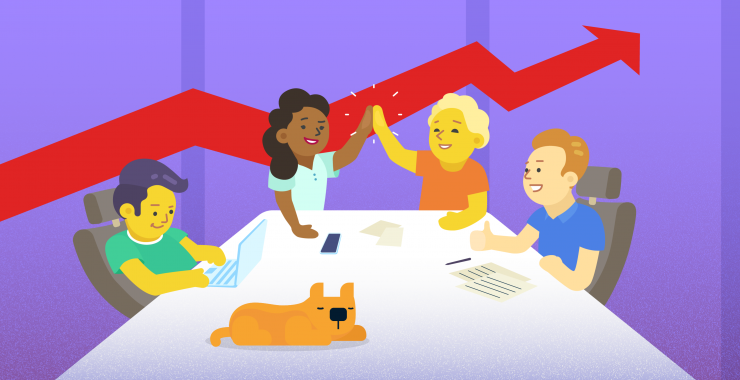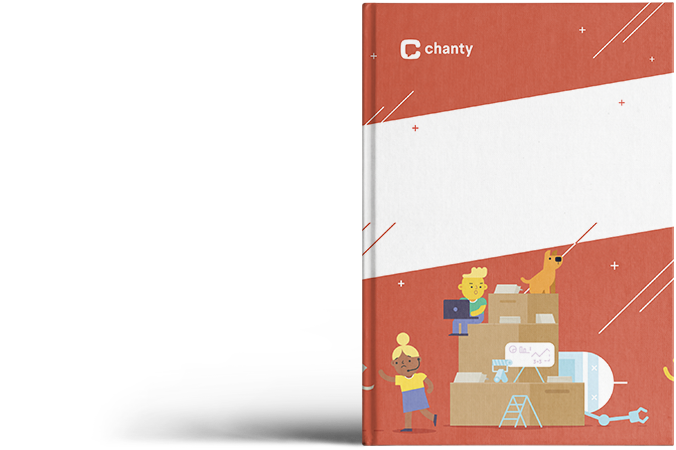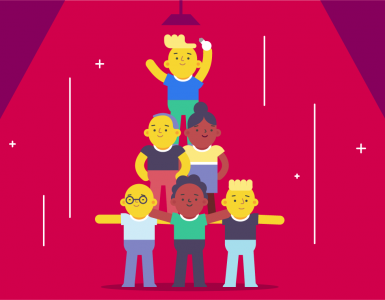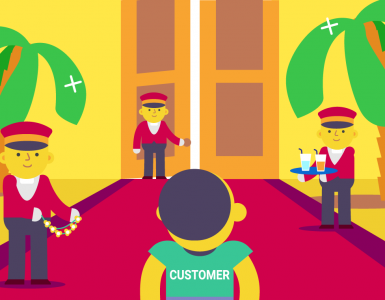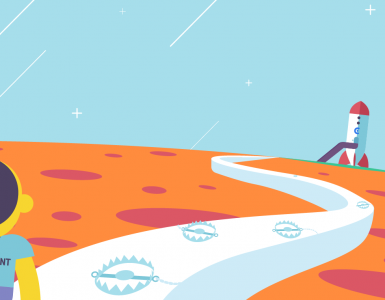The best work teams are those that are well-structured, know how to communicate and interact with each other. Motivation, participation, organization, commitment, trust, common objectives and problem solving are the seven fundamental characteristics of teamwork.
Do you know the advantages of teamwork, what its characteristics are, what group dynamics are the most useful? We’ll tell you.
The importance of teamwork
Teamwork is very important for the company to succeed and reach business objectives. All employees play specific roles, depending on their strengths, that contribute to the overall results. Therefore, good teamwork improves productivity. A bad one, however, can generate the opposite.
In fact, it is important not only how the different members of the group work with each other and how they complement each other but also the atmosphere in the team—the work climate. A good one will foster motivation and belonging to the entity.
Unfortunately, many organizations still rely on individual talents, but do not take into account the possible integration of these members in the team they will be part of. Business projects in which a group of people with different knowledge, experience and ideas cooperate and share them, are the ones that achieve success.
Advantages of teamwork
The advantages of teamwork are obtained when new and different ideas are brought together to provide better solutions. When the employee feels fulfilled and an important part of that team, everything flows. The main benefits of teamwork are:
Personal and collective growth
The team made up of people with very different knowledge and attitudes, generates a high level of personal enrichment. When everyone shares their perspectives and skills they strengthen the group. Encouraging team members to form meaningful mentoring relationships (sometimes using mentoring software for unbiased matching on larger teams) accelerates their personal and professional development. Teams like this turn the work into something productive and rewarding that makes the rest progress.
Encourages creativity
Listening to different points of view stimulates the creativity of all team members and provides more effective solutions to any setbacks that may arise.
Moreover, allowing team members to step outside their regular roles and take on different responsibilities within the team can spark creativity. It encourages out-of-the-box thinking and nurtures a sense of ownership and empowerment. In the long term, a creative team is one that can quickly adapt to challenges and seize opportunities.
Increases motivation
Team made decisions are not imposed by one person. This makes the workers feel like an important part of the company and that they are taken into account. The atmosphere improves and the work motivation grows.
Effective use of recognition tools – such as celebrating team milestones, offering small rewards, or providing positive feedback – can further enhance motivation. Recognition not only boosts morale but also promotes a healthy competitive spirit that drives performance and commitment across the team.
The synergy grows
With teamwork, tasks are divided, employee stress is reduced and productivity increases. Synergy grows because working together produces better results than individual work.
Implementing collaborative platforms, such as team messaging tools, project management software, or document sharing applications, can streamline the teamwork process. This digital infrastructure enables seamless coordination, task tracking, and easy access to resources, ultimately optimizing efficiency and ensuring no task is left undone.
Improved communication
In companies where teamwork is encouraged, communication is more fluid and direct because different opinions can be conveyed without anyone taking them negatively. As a result, the working environment and problem-solving are improved. A transparent communication culture reduces misunderstandings and builds trust between team members, which is essential for overcoming obstacles.
Regular communication rituals, such as weekly check-ins or team stand-ups, help maintain open channels for feedback and ensure alignment. Additionally, encouraging informal conversations – whether through team chats or casual coffee breaks – helps build rapport, which makes team members more comfortable sharing their ideas and concerns.
Seven characteristics of teamwork
Common and defined objectives
If the team members know the objectives and the deadline for achieving them perfectly, it will be easier for them to work together optimally.
Only by having clear objectives and joining forces in the same direction can the group succeed.
Solving problems
Sometimes, you can’t solve a problem on the first try. In that case, the group needs to be cohesive and work to solve the problems in the best possible way. Searching for culprits will only generate a bad work climate and slow down all the processes.
It is very important to evaluate the situation, detect the mistakes, and bring together the ideas of all the group members to correct them as soon as possible in the most effective way.
Good communication and motivation
It is essential to involve everyone in the project, count on their ideas, and inform all the members of the group with maximum transparency. If there is good communication and people feel valued, motivation and commitment to the organization will increase.
In short, creating a common identity and generating a sense of belonging to the company, for each of the employees, is decisive for teamwork to work.
Participatory teamwork
Decisions must be made in consensus with all team members. Discussing the different ideas and integrating people will bring better results than if the actions are taken unilaterally by the team leaders.
Feeling involved in the whole project also contributes to a higher degree of commitment and sense of belonging.
Organized teamwork
The work team has to be perfectly defined and organized. The tasks of each employee must be planned. This requires:
- A project that reflects the objectives,
- The means available or necessary to achieve them,
- The periods for achieving each of them and contemplating possible risks.
Although it is the team leader who usually makes the final planning, it is important to reflect the ideas of the employees and they agree with everything before imposing anything.
Commitment
Only when team members are committed to the project can it achieve success. People commit when they trust and believe in what they are doing. A team member’s commitment will result in a pattern of imitation that can be extended to the rest of the group.
Trust in the team
Trust in others is essential in teamwork. This trust is earned by what you say but, above all, by what you do.
Collaboration between team members is very necessary. This is the only way to achieve your goals. No matter how well a person works, teamwork will not work if they do not act in harmony and trust each other.
Five activities to encourage teamwork
Working as a team increases the effectiveness of the results, but it is not always easy for very different people to fit together. That is why it is advisable in companies to carry out activities to encourage teamwork:
The communicator
It is one of the most effective team building activities. It serves to check and enhance the communication skills of team members.
One of them makes a drawing that the rest cannot see. They will have to draw what they think it is, with the instructions given by the person who made the drawing. At the end, the original will be compared with what each of the team members have painted.
With the same guidelines, the drawings are usually so varied that reflection on the importance of listening, speaking and interpreting the words of others is encouraged.
The cubes
This group dynamic analyzes each person’s skills and, thus, distributes the tasks correctly.
What does it consist in? The team members are divided into several groups. All the teams will have the task of creating the same number of paper cubes, but they will have different materials.
For example, one group will have one pair of scissors, another three, and so on. Once the test is over, the quality and quantity of the cubes made will be checked. The process, results, and problem-solving will be analyzed.
The time
In this teamwork activity, the team is divided in two. They will compete to finish a challenge, such as a puzzle, in a given time.
This exercise will help us see the difficulties that arise in the organization of work, the conflicts for leadership, how they negotiate with each other, and how they discuss. By examining all these situations, we will be able to better solve the deficiencies.
The lifesaver
This group activity improves team collaboration and interpersonal communication and teaches how to make equitable decisions.
Different people play the roles of a young man, an old man, a child, a middle-aged woman, a priest, etc. – the rest of the members will have to come to an agreement to save just one. They will have to decide which decision would be the most correct one not to end the human species. This is one of the most fun team-building activities.
Dissatisfied customer
In this case, one person will act as a dissatisfied customer and another as a dependent who must resolve the situation. The attitude, words and, in short, the way in which the emotional intelligence is used to transform a dissatisfied client into a happy one, will be valued.
The rest of the team members will go through each of the roles and the cases will be varied so that the latter do not have more time to think than the former.
Just get started
Establishing positive teamwork and collaboration is a time-consuming and painstaking process, but it is worth it. Once you get started, your employees will act like a united, unstoppable force.



